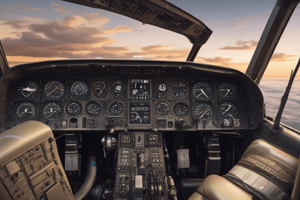Podcast
Questions and Answers
What is the maximum number of characters that can be represented by Extended ASCII?
What is the maximum number of characters that can be represented by Extended ASCII?
- 512 characters
- 128 characters
- 1024 characters
- 256 characters (correct)
Which of the following correctly defines a Kilobyte (KB)?
Which of the following correctly defines a Kilobyte (KB)?
- Approximately 100 bytes
- Exactly 1000 bytes
- Approximately 1024 bytes (correct)
- Approximately 2048 bytes
What is the encoding capacity of a Byte?
What is the encoding capacity of a Byte?
- 8 bits (correct)
- 1 bit
- 16 bits
- 4 bits
Which one of the following is the correct order of data storage units, from smallest to largest?
Which one of the following is the correct order of data storage units, from smallest to largest?
Which component did Von Neumann's model primarily describe?
Which component did Von Neumann's model primarily describe?
What does the clock frequency of a CPU indicate?
What does the clock frequency of a CPU indicate?
Which type of memory is used to store data temporarily during processing?
Which type of memory is used to store data temporarily during processing?
What is the primary purpose of Read Only Memory (ROM)?
What is the primary purpose of Read Only Memory (ROM)?
What principle does Moore's Law describe?
What principle does Moore's Law describe?
Which of the following accurately describes virtual memory?
Which of the following accurately describes virtual memory?
What does the term 'digital format' primarily refer to?
What does the term 'digital format' primarily refer to?
Which of the following best describes an analog signal?
Which of the following best describes an analog signal?
What is a bit in the context of the binary system?
What is a bit in the context of the binary system?
What is the maximum number of different combinations that a byte can represent?
What is the maximum number of different combinations that a byte can represent?
Which of the following statements about a digital signal is true?
Which of the following statements about a digital signal is true?
Which encoding scheme is known for including letters, numbers, and mathematical symbols?
Which encoding scheme is known for including letters, numbers, and mathematical symbols?
How does digital data differ from analog data?
How does digital data differ from analog data?
What is the primary characteristic of the binary system used in computers?
What is the primary characteristic of the binary system used in computers?
What does RFID stand for?
What does RFID stand for?
Which of the following best describes the function of an RFID reader?
Which of the following best describes the function of an RFID reader?
What is the primary technology used in RFID for communication?
What is the primary technology used in RFID for communication?
Which storage technology is considered solid state?
Which storage technology is considered solid state?
What does MIPS stand for in the context of computer performance?
What does MIPS stand for in the context of computer performance?
Which type of computer is described as allowing access to numerous users?
Which type of computer is described as allowing access to numerous users?
What is the primary advantage of using RFID technology over traditional barcodes?
What is the primary advantage of using RFID technology over traditional barcodes?
Which of the following is NOT a type of output technology?
Which of the following is NOT a type of output technology?
What is the primary function of the Arithmetic Logic Unit (ALU)?
What is the primary function of the Arithmetic Logic Unit (ALU)?
Which device is specifically designed for cursor movement and selection?
Which device is specifically designed for cursor movement and selection?
Which component of a QR Code is crucial for indicating the start of the information?
Which component of a QR Code is crucial for indicating the start of the information?
What is the main purpose of a QR Code?
What is the main purpose of a QR Code?
Which command is used in Windows to check the functionality of qrencode after installation?
Which command is used in Windows to check the functionality of qrencode after installation?
Which type of barcode provides a quiet zone, start character, and stop character within its encoding structure?
Which type of barcode provides a quiet zone, start character, and stop character within its encoding structure?
What does the 'FNC1' represent in a Code 128 Barcode?
What does the 'FNC1' represent in a Code 128 Barcode?
What type of input device is a touch pad?
What type of input device is a touch pad?
Flashcards
ASCII
ASCII
A character encoding standard that uses 7 bits to represent 128 characters.
Extended ASCII
Extended ASCII
A character encoding standard that extends ASCII by using 8 bits to represent 256 characters, allowing for more symbols.
Byte
Byte
A unit of digital information that consists of 8 bits.
Kilobyte (KB)
Kilobyte (KB)
Signup and view all the flashcards
Von Neumann architecture
Von Neumann architecture
Signup and view all the flashcards
Digital Format
Digital Format
Signup and view all the flashcards
Analog Signal
Analog Signal
Signup and view all the flashcards
Digital Signal
Digital Signal
Signup and view all the flashcards
Binary System
Binary System
Signup and view all the flashcards
Binary Encoding
Binary Encoding
Signup and view all the flashcards
Input Device
Input Device
Signup and view all the flashcards
Output Device
Output Device
Signup and view all the flashcards
Central Processing Unit (CPU)
Central Processing Unit (CPU)
Signup and view all the flashcards
Arithmetic Logic Unit (ALU)
Arithmetic Logic Unit (ALU)
Signup and view all the flashcards
Communication Bus
Communication Bus
Signup and view all the flashcards
Mouse
Mouse
Signup and view all the flashcards
QR Code
QR Code
Signup and view all the flashcards
Barcode
Barcode
Signup and view all the flashcards
What is RAM?
What is RAM?
Signup and view all the flashcards
Why is ROM important?
Why is ROM important?
Signup and view all the flashcards
What does Cache do?
What does Cache do?
Signup and view all the flashcards
What is Virtual Memory?
What is Virtual Memory?
Signup and view all the flashcards
What role does CMOS play?
What role does CMOS play?
Signup and view all the flashcards
RFID
RFID
Signup and view all the flashcards
RFID Tag
RFID Tag
Signup and view all the flashcards
RFID Reader
RFID Reader
Signup and view all the flashcards
Multitouch
Multitouch
Signup and view all the flashcards
3D Touch
3D Touch
Signup and view all the flashcards
Hard Disk
Hard Disk
Signup and view all the flashcards
Solid State Drive (SSD)
Solid State Drive (SSD)
Signup and view all the flashcards
Mainframe Computer
Mainframe Computer
Signup and view all the flashcards
Study Notes
Information Systems
- Course offered by the Faculty of Economics at the Università Cattolica del Sacro Cuore
- Academic year 2024/2025
Information System Infrastructure
- Binary System
- Hardware
- Software
- Network and Communication System
Digital Format
- Representation of information (e.g., music, documents) in a way that allows processing by information technologies
- "Digital" derives from the English word "digit," meaning "number" or "figure"
- Digital format is equivalent to numerical format
Analog Signal
- A signal is considered analog when the values representing it are continuous (infinite)
- Analog signals are comparable to waves, transmitting a wide spectrum of information.
- Analog signals are highly susceptible to interference (jitter).
Digital Signal
- Digital signals can only take on two easily distinguishable states, typically 0 and 1
- Advantages of digital signals are higher resolution and less interference
Binary System
- The electronic system used by computers to represent data and instructions.
- Data and instructions are represented as 0s and 1s.
Bit
- The smallest unit of information a computer can process.
Byte
- Composed of 8 bits.
- Represents the fundamental unit of language in electronic computing.
- Smallest unit of memory capable of holding a character.
- 8 bits can differentiate 256 different combinations of 0s and 1s (28).
ASCII
- Code that includes conventional characters, numbers, mathematical symbols, and Greek letters.
- ASCII uses 7 bits to represent 128 different characters.
Extended ASCII
- Includes 256 characters and different versions for national characters with additional 15 extensions (8 bits).
Memory Measurements
- bit: A single binary digit (0 or 1)
- Byte: 8 bits
- Kilobyte (KB): approximately 1,000 bytes (210 bytes)
- Megabyte (MB): approximately 1 million bytes (220 bytes)
- Gigabyte (GB): approximately 1 billion bytes (230 bytes)
- Terabyte (TB): approximately 1 trillion bytes (240 bytes)
- Petabyte (PB): approximately 1 quadrillion bytes (250 bytes)
- Exabyte (EB): approximately 1 quintillion bytes (260 bytes)
- Zettabyte (ZB): approximately 1 sextillion bytes (270 bytes)
- Yottabyte (YB): approximately 1 septillion bytes (280 bytes)
Hardware
- Von Neumann modeled the logical framework for computer operation, still valid today.
- CPU (Central Processing Unit) with Arithmetic Logic Unit (ALU) and Control Unit (CU).
- Input/output devices and communication bus.
- Storage Unit
- Input devices: Keyboard(QWERTY, Ergonomic); Mouse; Pointing stick; Joystick; Touch Screen; Touch Pad; Scanner; Barcode/OCR reader; OMR reader; Microphone; Digital Camera; Digital Video;
Input Devices
- Peripheral devices for inputting data, such as:
- Text/Number input (QWERTY, Ergonomic Keyboard)
- Pointing (Mouse, Pointing Stick, Joystick)
- Batch data Entry (Scanner, Barcode/ OCR reader, OMR reader)
- Audio and video input (Microphone, Digital Camera, Digital Video)
- Emerging technologies (Laser Keyboard, Voice Recognition, Eye Tracking)
Mouse
- A pointing device.
- Manages a cursor.
- Components: selection buttons and cursor movement (ball or optical technology).
Barcode Readers
- Sections of Code 128 Barcode, including Quiet zone, Start character, [FNC1] + data encoding, Check character, and Stop character.
QR quick response code
- Barcode 2.0, interactive and multimedia.
- To scan a QR code, specific applications are required
- QR codes compress information.
- Once scanned, QR codes translate to usable information.
QR - Demo
- Instructions to copy VCARD content, save as a file and execute commands, for Windows, Linux, and OS X.
- Instructions to open the created file and scan with a smartphone.
RFID radio frequency identification
- Automatic identification and Data Capture (AIDC).
- Based on tags or transponders(electronic tags, proximity keys).
- Readers communicate with tags to store and retrieve data
- Data Transmission is radio frequency.
Output Technology
- Output video (Printer, Inkjet printer, Laser printer, Multifunctional printer, 3D printer, Plotter)
- Output audio
input and output: touch screen
- Functions: Multitouch, Pinch to zoom, 3D Touch
Storage
- Hard disk and solid-state devices.
- Floppy Disk
- CD, DVD and Blu-ray Disk
- Magnetic Tape
- Memory Stick
Compare memory storage tech
- Comparison of different types of memory (Magnetic Tape, Hard Disk, CD, DVD, Memory Stick), their speed, data access method, and cost of 1 MB of storage.
Computer Types
- Supercomputer (High performance).
- Mainframe.
- Workstation.
- Personal Computer
- Mobile Device
- physical dimensions, Typical use, RAM memory, cost in Euros.
HPC - High Performance Computing
- Most powerful supercomputers in the world.
- Performance measured in trillion operations per second.
- Ranking of fastest computers.
Mainframe
- MIPS: Million Instructions Per Second (approximately 18,000)
Computer (Workstation)
- Access to numerous users in SMEs or departments.
Microcomputer and microcontroller
- General-purpose microprocessors and microcontrollers.
Architecture of a Personal Computer
- Block diagram of a personal computer architecture.
- Components: RAM, ROM, Micro-processor, Hard disk, Network, Modem, Floppy disk, CD-ROM, Mouse, Keyboard, Screen, Audio, Printer.
Central Unit
- Operating frequency affects performance.
- Multicore processors: Dual, Quad, Eight.
The Moore's Law
- Processor performance and the number of transistors double roughly every 18 months
Central Memory
- RAM (Random Access Memory): temporary storage.
- Volatile: data lost when the power is off.
- ROM (Read-Only Memory): permanent storage.
- Cache (L1 and L2): temporary high-speed memory.
- Virtual Memory: extends RAM capacity using the hard disk
- CMOS: maintains configuration settings; powered by a battery.
Studying That Suits You
Use AI to generate personalized quizzes and flashcards to suit your learning preferences.




